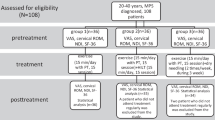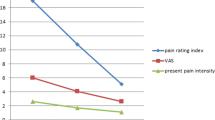Abstract
The objective of this study was to test the hypothesis that dry needling is more effective than sham dry needling in the treatment of myofascial pain syndrome (MPS). This was a prospective, double-blinded, randomized-controlled study conducted in an outpatient clinic. Thirty-nine subjects with established myofascial trigger points were randomized into two groups: study group (N = 22) and placebo group (N = 17). Dry needling was applied using acupuncture needles, and sham dry needling was applied in the placebo group. The treatment was composed of six sessions which were performed in 4 weeks; the first four sessions were performed twice a week (for 2 weeks) and the last two, once a week (for 2 weeks). The visual analog scale (VAS) and Short Form-36 (SF-36) were used. When compared with the initial values, VAS scores of the dry needling group following the first and sixth sessions were significantly lower (p = 0.000 and p < 0.000, respectively). When VAS scores were compared between the groups, the first assessment scores were found to be similar, but the second and third assessment scores were found to be significantly lower in the dry needling group (p = 0.034 and p < 0.001, respectively). When SF-36 scores of the groups were compared, both the physical and mental component scores were found to be significantly increased in the dry needling group, whereas only those of vitality scores were found to be increased significantly in the placebo (sham needling) group. The present study shows that the dry needling treatment is effective in relieving the pain and in improving the quality of life of patients with MPS.





Similar content being viewed by others
Abbreviations
- MPS:
-
Myofascial pain syndrome
- RCTs:
-
Randomized clinical trials
- VAS:
-
Visual analog scale
- QoL:
-
Quality of life
References
Simons DG, Travell JG, Simons PT (1999) Travell and Simons' myofascial pain and dysfunction: the trigger point manual. Williams & Wilkins, Baltimore, pp 11–93
Simons DG (2002) Understanding effective treatments of myofascial trigger points. J Bodywork Movement Therap 6:81–88
Borg-Stein J, Simons DG (2002) Focused review: myofascial pain. Arch Phys Med Rehabil 83:40–49
Skootsky SA, Jaeger B, Oye RK (1989) Prevalence of myofascial pain in general internal medicine practice. West J Med 151:157–160
Lavelle ED, Lavelle W, Smith HS (2007) Myofascial trigger points. Med Clin N Am 91:229–239
Cummings TM, White AR (2001) Needling therapies in the management of myofascial trigger point pain: a systematic review. Arch Phys Med Rehabil 82:986–992
King JC, Goddard MJ (1994) Pain rehabilitation: chronic pain syndrome and myofascial pain syndrome. Arch Phys Med Rehabil 75:9–14
Lewit K (1979) The needle effect in the relief of myofascial pain. Pain 6:83–90
Hong CZ (1994) Lidocaine injection versus dry needling to myofascial trigger point. The importance of the local twitch response. Am J Phys Med Rehabil 73:256–263
Barbagli P, Bollettin R, Ceccherelli F (2003) Acupuncture (dry needle) versus neural therapy (local anesthesia) in the treatment of benign back pain. Immediate and long-term results. Minerva Med 94:17–25
Ga H, Choi JH, Park CH, Yoon HJ (2007) Acupuncture needling versus lidocaine injection of trigger points in myofascial pain syndrome in elderly patients—a randomised trial. Acupunct Med 25:130–136
Cline ME, Herman J, Shaw ER, Morton RD (1992) Standardization of the visual analogue scale. Nurs Res 41:378–380
Demirsoy C (1999) The MOS-SF 36 health survey: a validation study with a Turkish sample. Master tezi, Boğaziçi Üniversitesi, İstanbul
Tough EA, White AR, Cummings TM, Richards SH, Campbell JL (2009) Acupuncture and dry needling in the management of myofascial trigger point pain: a systematic review and meta-analysis of randomised controlled trials. Eur J Pain 13:3–10
DiLeronzo L, Traballesi M, Morelli D, Pompa A, Brunelli S, Buzzi MG et al (2004) Hemiparatic shoulder pain syndrome treating with dry needling during early rehabilitation: a prospective, open-labed, randomized investigation. J Musculoskel Pain 12:25–34
Chu J (1997) Does EMG (dry needling) reduce myofascial pain symptoms due to cervical nerve root irritation? Electromyogr Clin Neurophysiol 37:259–272
Itoh K, Katsumi Y, Kitakoji H (2004) Trigger point acupuncture treatment of chronic low back pain in elderly patients—a blinded RCT. Acupunct Med 22:170–177
Huguenin L, Brukner PD, McCrory P, Smith P, Wajswelner H, Bennell K (2005) Effect of dry needling of gluteal muscles on straight leg raise: a randomised, placebo controlled, double blind trial. British Journal of Sports Medicine 39:84–90
Ilbuldu E, Cakmak A, Disci R, Aydin R (2004) Comparison of laser, dry needling, and placebo laser treatments in myofascial pain syndrome. Photomed Laser Surg 22:306–311
Itoh K, Katsumi Y, Hirota S, Kitakoji H (2006) Effects of trigger point acupuncture on chronic low back pain in elderly patients—a sham-controlled randomised trial. Acupunct Med 24:5–12
Itoh K, Katsumi Y, Hirota S, Kitakoji H (2007) Randomised trial of trigger point acupuncture compared with other acupuncture for treatment of chronic neck pain. Compl Ther Med 15:172–179
Sterling M, Valentin S, Vicenzino B, Souvlis T, Connelly LB (2009) Dry needling and exercise for chronic whiplash—a randomised controlled trial. BMC Musculoskelet Disord 10:160
Goddard G, Karibe H, McNeill C, Villafuerte E (2002) Acupuncture and sham acupuncture reduce muscle pain in myofascial pain patients. Journal of Orofacial Pain 16:71–76
Gunn CC (1996) The Gunn approach to the treatment of chronic pain; intramuscular stimulation for myofascial pain of radiculopathic origin. Churchill Livingston, New York, pp 11–37
Streitberger K, Kleinhenz J (1998) Introducing a placebo needle into acupuncture research. Lancet 352:364–365
Park J, White AR, Lee H, Ernst E (1999) Development of a new sham needle. Acupunct Med 17:110–112
Ceccherelli F, Rigoni MT, Gagliardi G, Ruzzante L (2002) Comparison of superficial and deep acupuncture in the treatment of lumbar myofascial pain: a double-blind randomized controlled study. Clin J Pain 18:149–153
Kawakita K (1993) Polymodal receptor hypothesis on the peripheral mechanisms of acupuncture and moxibustion. Am J Acupunct 21:331–338
Hong CZ (1994) Persistence of local twitch response with loss of conduction to and from the spinal cord. Arch Phys Med Rehabil 75:12–16
Chen JT, Chung KC, Hou CR, Kuan TS, Chen SM, Hong CZ (2001) Inhibitory effect of dry needling on the spontaneous electrical activity recorded from myofascial trigger spots of rabbit skeletal muscle. Am J Phys Med Rehabil 80:729–735
Disclosures
None.
Author information
Authors and Affiliations
Corresponding author
Rights and permissions
About this article
Cite this article
Tekin, L., Akarsu, S., Durmuş, O. et al. The effect of dry needling in the treatment of myofascial pain syndrome: a randomized double-blinded placebo-controlled trial. Clin Rheumatol 32, 309–315 (2013). https://doi.org/10.1007/s10067-012-2112-3
Received:
Revised:
Accepted:
Published:
Issue Date:
DOI: https://doi.org/10.1007/s10067-012-2112-3




